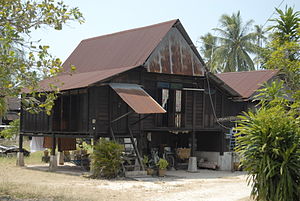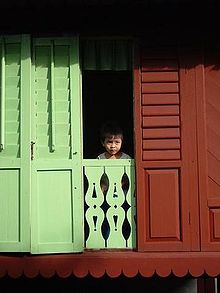- Malay houses
-
Malay houses are traditional dwellings, originating before the arrival of foreign or modern influences, and constructed by the indigenous ethnic Malay and Orang Asli peoples of the Malay Peninsula and their related Bumiputra tribes of East Malaysia.
Whereas peninsular Malays have single extended-family houses, many of the Borneo people built rumah panjang or 'long-houses' hosting many families, each in its own 'apartment' with a common wide veranda linking the front.
Traditional architectural forms, such as tropically-suited roofs and harmonious proportions with decorative elements are considered by traditionalists to still have relevance. However traditional buildings require significant maintenance compared to modern construction. These traditional skills are gradually being lost as Malaysia continues its process of industrialisation.
Contents
Construction
Using renewable natural materials including timber and bamboo, the dwellings are often built without the use of metal including nails. Instead pre-cut holes and grooves are used to fit the timber elements into one another, effectively making it a ‘prefabricated house’. In Sarawak and Sabah rattan ropes were used to fasten bamboo pieces together.
Although nails had been invented and in later houses used minimally for non-structural elements (for example, windows or panels), structural flexibility was a benefit which nailing inhibited. Without nails, a timber house could be dismantled and reconstructed in a new location.
Design
Traditional timber houses incorporated design principals relevant in contemporary architecture such as shading and ventilation, qualities present in the basic house features. A main characteristic of a typical kampung house is its on stilts or piles. This was to avoid wild animals and floods, to deter thieves, and for added ventilation. In parts of Sabah, the number of dowry buffaloes could even depend on the number of stilts there are in the bridal family’s home.
A traditional Malay timber house usually in two parts: the main house called Rumah Ibu in honour of the mother (ibu) and the simpler Rumah Dapur or kitchen annex, which was separated from the main house for fire protection. Proportion was important to give the house a human scale. The Rumah Ibu was named after the spacings between stilts which are said to typically follow the arms-spread width of the wife and mother in the family of the house when being built. At least one raised veranda (serambi) is attached to the house for seated work or relaxation, or where non-familiar visitors would be entertained, thus preserving the privacy of the interior.
Decoration
Each state or ethnic group has its own regional or group style of house or preferred details. For example, in Melaka the staircase is always decoratively moulded and colourfully tiled. In Peninsular Malaysia’s east coast, many houses have distinctive carved roof gable-end boards akin to those in Thailand and Cambodia.
Cultural references
Most of the ancient Malay peoples of South-East Asia maintained a form of self-regenerating environmental culture.
Types
- Rumah Limas - Predominantly found in Johor, Malacca, Pahang, Terengganu and Selangor.
- Rumah Melaka - Predominantly found at Johor and Malacca.
- Rumah Minangkabau - Predominantly found at Negeri Sembilan.
- Rumah Bumbung Panjang Selangor - Predominantly found in Selangor.
- Rumah Kutai - Predominantly found in Perak and northern Selangor.
See also
- Architecture of Indonesia
- Architecture of Sumatra
Further reading
- Ariffin, A. Najib; "A Disappearing Heritage: The Malaysian Kampung House", in Heritage Asia (Kuala Lumpur: Mediahub), September 2005, 6-8 -Passages in the above entry appear with permission of the Author/Publisher
- Lee Ho Yin, "The Kampong House: An Evolutionary History of Peninsular Malaysia's Vernacular Houseform," in Asia's Old Dwellings: Tradition, Resilience, and Change, ed. Ronald G. Knapp (New York: Oxford University Press), 2003, 235-258.
- Yuan, Lim Jee; "The Malay House: Principles to Building Simple and Beautiful Homes for Comfort and Community" (Fox Chapel Publishing), 2010.
Categories:- Houses in Malaysia
- Malay culture
- Malaysian architecture
- Indonesian architecture
Wikimedia Foundation. 2010.


